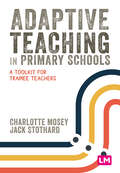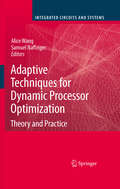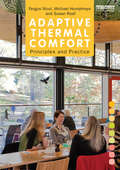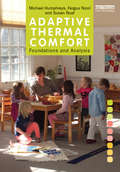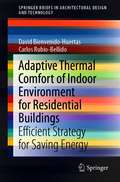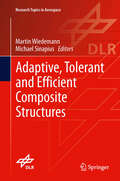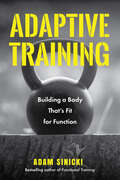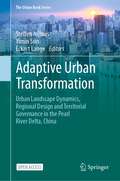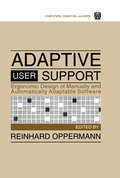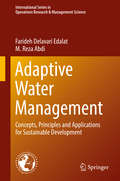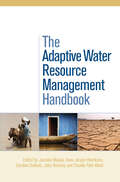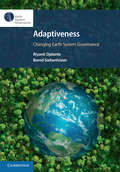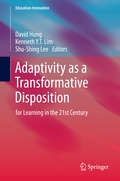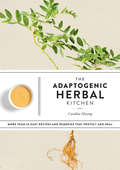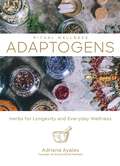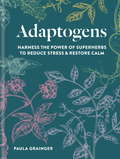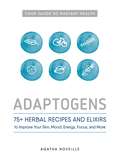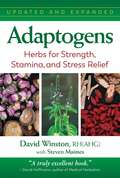- Table View
- List View
Adaptive Teaching in Primary Schools: A toolkit for trainee teachers (Primary Teaching Now)
by Charlotte Mosey Jack StothardA guide for trainee and beginning teachers on Adaptive Teaching. This book explores what we mean by ′Adaptive Teaching′ and considers this in the current context of schools and teaching in the UK. It includes key theory to support trainee teachers′ foundation knowledge. Importantly, the text focuses on practical support for classroom teaching and includes suggested approaches and examples of good practice to learn from and adapt. ′How to′ guidance supporting trainees on placements and in their first years of teaching.
Adaptive Techniques for Dynamic Processor Optimization: Theory and Practice (Integrated Circuits and Systems)
by Alice Wang Samuel NaffzigerThis book is about various adaptive and dynamic techniques used to optimize processor power and performance. It is based on a very successful forum at ISSCC which focused on Adaptive Techniques. The book looks at the underlying process technology for adaptive designs and then examines different circuits, architecture and software that address the different aspects. The chapters are written by people both in academia and the industry to show the scope of alternative practices.
Adaptive Technologies for Training and Education
by Paula J. Durlach Alan M. LesgoldThis edited volume provides an overview of the latest advancements in adaptive training technology. Intelligent tutoring has been deployed for well-defined and relatively static educational domains such as algebra and geometry. However, this adaptive approach to computer-based training has yet to come into wider usage for domains that are less well defined or where student-system interactions are less structured, such as during scenario-based simulation and immersive serious games. In order to address how to expand the reach of adaptive training technology to these domains, leading experts in the field present their work in areas such as student modeling, pedagogical strategy, knowledge assessment, natural language processing and virtual human agents. Several approaches to designing adaptive technology are discussed for both traditional educational settings and professional training domains. This book will appeal to anyone concerned with educational and training technology at a professional level, including researchers, training systems developers and designers.
Adaptive Technology for the Internet: Making Electronic Resources Accessible to All
by Barbara T. MatesIs your site accessible? Can helen keller access your site? With all the new technology and our societies reliance on technology the demand for assistive technology increases. Read about different pieces of equipment that can make surfing the net more enjoyable for those with disabilities.
Adaptive Thermal Comfort: The Designer's Guide To Adaptive Thermal Comfort
by Susan Roaf Michael Humphreys Fergus NicolThe fundamental function of buildings is to provide safe and healthy shelter. For the fortunate they also provide comfort and delight. In the twentieth century comfort became a 'product' produced by machines and run on cheap energy. In a world where fossil fuels are becoming ever scarcer and more expensive, and the climate more extreme, the challenge of designing comfortable buildings today requires a new approach. This timely book is the first in a trilogy from leaders in the field which will provide just that. It explains, in a clear and comprehensible manner, how we stay comfortable by using our bodies, minds, buildings and their systems to adapt to indoor and outdoor conditions which change with the weather and the climate. The book is in two sections. The first introduces the principles on which the theory of adaptive thermal comfort is based. The second explains how to use field studies to measure thermal comfort in practice and to analyze the data gathered. Architects have gradually passed responsibility for building performance to service engineers who are largely trained to see comfort as the ‘product’, designed using simplistic comfort models. The result has contributed to a shift to buildings that use ever more energy. A growing international consensus now calls for low-energy buildings. This means designers must first produce robust, passive structures that provide occupants with many opportunities to make changes to suit their environmental needs. Ventilation using free, natural energy should be preferred and mechanical conditioning only used when the climate demands it. This book outlines the theory of adaptive thermal comfort that is essential to understand and inform such building designs. This book should be required reading for all students, teachers and practitioners of architecture, building engineering and management – for all who have a role in producing, and occupying, twenty-first century adaptive, low-carbon, comfortable buildings.
Adaptive Thermal Comfort: Foundations And Analysis
by Susan Roaf Michael Humphreys Fergus NicolThere has been widespread dissatisfaction with accepted models for predicting the conditions that people will find thermally comfortable in buildings. These models require knowledge about clothing and activity, but can give little guidance on how to quantify them in any future situation. This has forced designers to make assumptions about people’s future behaviour based on very little information and, as a result, encouraged static design indoor temperatures. This book is the second in a three volume set covering all aspects of Adaptive Thermal Comfort. The first part narrates the development of the adaptive approach to thermal comfort from its early beginnings in the 1960s. It discusses recent work in the field and suggests ways in which it can be developed and modelled. Such models can be used to set dynamic, interactive standards for thermal comfort which will help overcome the problems inherited from the past. The second part of the volume engages with the practical and theoretical problems encountered in field studies and in their statistical analysis, providing guidance towards their resolution, so that valid conclusions may be drawn from such studies.
Adaptive Thermal Comfort of Indoor Environment for Residential Buildings: Efficient Strategy for Saving Energy (SpringerBriefs in Architectural Design and Technology)
by David Bienvenido-Huertas Carlos Rubio-BellidoThis book is structured in four parts: First, it analyzes the sustainability objectives established for the building stock and the importance of thermal comfort in this aspect. Second, the existing adaptive thermal comfort models and the main energy-saving measures associated with these models are analyzed. Third, the energy savings obtained with these measures are analyzed in several case studies, comparing the results obtained with other energy conservation measures, such as the improvement of the façade. The analysis is carried out from an energy and economic perspective. Finally, a decision‐making process based on fuzzy logic is established. As an expected result, the content of the book contributes to assist architects in designing more efficient buildings from the perspective of user behavior.
Adaptive, tolerant and efficient composite structures: Adaptive, Tolerant And Efficient Composite Structures (Research Topics in Aerospace)
by Martin Wiedemann Michael SinapiusComposite structures are most efficient in performance and production cost when combined with smart materials making them adaptable to changing operational conditions. The specific production processes of composites offer the possibility to integrate more functions thus making the structure more valuable. Active functions can be realized by smart materials, e.g. morphing, active vibration control, active structure acoustic control or structure health monitoring. The foundation is a sound understanding of materials, design methods, design principles, production technologies and adaptronics. Along the complete process chain this disciplines together deliver advanced lightweight solutions for applications ranging from mechanical engineering to vehicles, airframe and finally space structures. This book provides the scientific foundations as well as inspiring new ideas for engineers working in the field of composite lightweight structures.
Adaptive Training: Building a Body That's Fit for Function
by Adam SinickiEvolutionary Lifestyle Fitness Strategies“Definitely one of the most holistic fitness and training personalities of the modern era.” ─Amazon review #1 New Release in Physical Education and Stretching Exercise & FitnessAdaptive Training explores an alternate perspective on health and fitness focusing on how we are a product of the environment. So change your surroundings to maximize your health and fitness beyond the gym.Explore your amazingly adaptable body. Tight hip flexors, rounded shoulders and a hunched back are all products of our daily lifestyles. We are adaptoids; our bodies are designed to adapt to our surroundings, and understanding this is the key to unlocking perfect performance. Adaptive Training takes you through the fundamentals of understanding adaptive training while providing a detailed physical fitness program to help you build an environment that facilitates a healthy and empowering new lifestyle fitness journey with new lifestyle fitness equipment.Unlock your true potential. The best way to learn a language is through immersion, and the same is true for developing and maintaining a new lifestyle fitness. A few hours a week training at the gym or elsewhere is great, but what if your environment outside of the gym is also challenging your body? You will see results that are only possible through the innovative fitness method called “Adam” which stands for Adaptive Immersion Training. Change your environment with intent, and your body will adapt with amazing results.Inside, you’ll learn:How the environment shapes your body to be adaptiveHow and why you should divide training throughout the dayThe missing fundamentals of human movement and lifestyle fitness equipmentIf you are a fan of Adam Sinicki's Functional Training and Beyond or liked Tactical Barbell, Built from Broken, The Comfort Crisis, or What Doesn’t Kill You, you’ll love Adaptive Training.
Adaptive Urban Transformation: Urban Landscape Dynamics, Regional Design and Territorial Governance in the Pearl River Delta, China (The Urban Book Series)
by Steffen Nijhuis Yimin Sun Eckart LangeThis open access book provides a cross-sectoral, integrative and multi-scale design and planning approach for adaptive urban transformation of fast urbanising deltas, taking the Pearl River Delta (China) as a case study. Deltaic areas are among the most promising regions in the world. Their strategic location and superior quality of their soils are core factors supporting both human development and the rise of these regions as global economic hubs. At the same time, however, deltas are extremely vulnerable to multiple threats from both climate change and urbanisation. These include an increased flood risk combined with the resulting loss of ecological and social-cultural values. To ensure a more sustainable future for these areas, spatial strategies are needed to strengthen resilience, i.e. help the systems to cope with their vulnerabilities as well as enhance their capacity to overcome natural and artificial threats.The book provides a unique approach that integrates research in urban landscape systems, territorial governance and visualisation techniques that will help to achieve more integrated and resilient deltas. Based on an assessment of the dynamics of change regarding the transformational cycles of natural and urban landscape elements, eco-dynamic regional design strategies are explored to reveal greater opportunities for the exploitation of natural and social-cultural factors within the processes of urban development.
Adaptive User Support: Ergonomic Design of Manually and Automatically Adaptable Software
by Reinhard OppermannThe potential of software applications to solve an array of office and administrative problems is increasing faster than the ability of users to exploit it. We need to make systems easier to learn and more comfortable to use. This book reports a major advance in the effort to accomplish both goals. Flexcel enables users to modify access and dialog dynamics to their specific requirements. Relying on a plan recognition feature, the system proposes adaptations or uses of adaptations. The ongoing conflict between the adaptive and the adaptable is resolved in an integration: user and system share the responsibility for the initiatives, decision-making and execution. A "critic" component of the system then analyzes the user's handling of the adaptation tools and suggests improvements. The system offers an environment in which users can explore as they learn. HyPlan implements the context-sensitive help that facilitates learning on demand. When the PLANET plan-recognition feature identifies the kinds of support for work that may possibly be required, HyPlan provides, on request, specific assistance in the form of hypermedia or animated displays and tutorials. Developmental research has shown that users take advantage of opportunities to adapt interfaces only in conjunction with help-functions -- which are accepted when they do not interrupt work. And studies by social scientists have shown that adaptations of technical systems have to be integrated into the overall process of organizational innovation and undertaken cooperatively. This book will stimulate all those concerned with software -- from computational, cognitive, ergonomic, or organizational standpoints -- to reconceive the relationship between design and user support.
Adaptive Water Management: Concepts, Principles and Applications for Sustainable Development (International Series in Operations Research & Management Science #258)
by Farideh Delavari Edalat M. Reza AbdiThis book explores a new framework of Adaptive Water Management (AWM) for evaluating existing approaches in urban water management. It highlights the need to adopt multidisciplinary strategies in water management while providing an in-depth understanding of institutional interactions amongst different water related sectors. The key characteristics of AWM i. e. polycentric governance, organisational flexibility and public participation are investigated and described through a critical review of the relevant literature. The book presents an empirical case study undertaken in a selected developing-country city to investigate the potential gaps between the current water management approaches and possible implementation of AWM. Feasibility of AWM operations is examined in an environment surrounded by established water management structure with centralised governance and an institutional process based on technical flexibility. The key elements of AWM performance are (re)structured and transformed into decision support systems. Multi criteria decision models are developed to facilitate quantification and visualization of the elements derived from the case study, which is involved with water companies and water consumers. The book describes how the concept of AWM, along with structuring suitable decision support systems, can be developed and applied to developing-country cities. The book highlights the barriers for applying the AWM strategies that include established centralised decision making, bureaucratic interactions with external organisations, lack of organisational flexibility within the institutions, and lack of recognition of public role in water management. The findings outline that despite the lack of adaptability in the current water management in the case study, as an example of developing countries, there are positive attitudes among water professionals and the public towards adaptability through public-institutional participation. /p>
The Adaptive Water Resource Management Handbook
by Claudia Pahl-Wostl Jaroslav Mysiak Caroline Sullivan John Bromley Hans Jørgen HenriksonThe complexity of current water resource management poses many challenges. Water managers need to solve a range of interrelated water dilemmas, such as balancing water quantity and quality, flooding, drought, maintaining biodiversity and ecological functions and services, in a context where human beliefs, actions and values play a central role. Furthermore, the growing uncertainties of global climate change and the long term implications of management actions make the problems even more difficult. This book explains the benefits, outcomes and lessons learned from adaptive water management (AWM). In essence AWM is a way of responding to uncertainty by designing policy measures which are provisional and incremental, subject to subsequent modification in response to environmental change and other variables. Included are illustrative case studies from seven river basins from across Europe, West Asia and Africa: the Elbe, Rhine, Guadiana, Tisza, Orange, Nile and Amudarya. These exemplify the key challenges of adaptive water management, especially when rivers cross national boundaries, creating additional problems of governance.
Adaptive Web Design: Crafting Rich Experiences with Progressive Enhancement
by Aaron GustafsonBuilding an elegant, functional website requires more than just knowing how to code. In Adaptive Web Design, Second Edition, you'll learn how to use progressive enhancement to build websites that work anywhere, won't break, are accessible by anyone--on any device--and are designed to work well into the future. This new edition of Adaptive Web Design frames even more of the web design process in the lens of progressive enhancement. You will learn how content strategy, UX, HTML, CSS, responsive web design, JavaScript, server-side programming, and performance optimization all come together in the service of users on whatever device they happen to use to access the web. Understanding progressive enhancement will make you a better web professional, whether you're a content strategist, information architect, UX designer, visual designer, front-end developer, back-end developer, or project manager. It will enable you to visualize experience as a continuum and craft interfaces that are capable of reaching more users while simultaneously costing less money to develop. When you've mastered the tenets and concepts of this book, you will see the web in a whole new way and gain web design superpowers that will make you invaluable to your employer, clients, and the web as a whole. Visit http://adaptivewebdesign. info to learn more.
Adaptive Wireless Communications
by Daniel W. Bliss Siddhartan GovindasamyAdopting a balanced mix of theory, algorithms and practical design issues, this comprehensive volume explores cutting-edge applications in adaptive wireless communications and the implications these techniques have for future wireless network performance. Presenting practical concerns in the context of different strands from information theory, parameter estimation theory, array processing and wireless communication, the authors present a complete picture of the field. Topics covered include advanced multiple-antenna adaptive processing, ad hoc networking, MIMO, MAC protocols, space-time coding, cellular networks and cognitive radio, with the significance and effects of both internal and external interference a recurrent theme throughout. A broad, self-contained technical introduction to all the necessary mathematics, statistics, estimation theory and information theory is included, and topics are accompanied by a range of engaging end-of-chapter problems. With solutions available online, this is the perfect self-study resource for students of advanced wireless systems and wireless industry professionals.
Adaptiveness: Finding Meaning in Apparent Noise
by Stephan H. HaeckelTo demonstrate the benefits of adopting a sense-and-respond business model in order to enable the organization to respond to a much broader spectrum of possible customer needs.
Adaptiveness: Changing Earth System Governance
by Bernd Siebenhüner Riyanti DjalanteRapid and transformational actions are ever more urgently needed to achieve a just, resilient, and ecologically sustainable global society, as envisioned and supported by the Sustainable Development Goals. Moreover, dynamic governance approaches are vital for addressing changing and uncertain conditions. At many levels, governance needs to be responsive and flexible - in one word - adaptive. This book provides a state-of-the-art review of the conceptual development of adaptiveness as a key concept in the environmental governance literature, complemented by applications from global, regional, and national levels. It reviews the politics of adaptiveness, investigates which governance processes foster adaptiveness, and discusses how, when and why adaptiveness influences earth system governance. It is a timely synthesis for students, researchers and practitioners interested in environmental governance, sustainability and social change processes. This is one of a series of publications associated with the Earth System Governance Project. For more publications, see www.cambridge.org/earth-system-governance.
Adaptivity as a Transformative Disposition: for Learning in the 21st Century (Education Innovation Series)
by Kenneth Y. T. Lim David Hung Shu-Shing LeeThis volume introduces the concept of 'adaptivity' as occurring when, say, individuals cross boundaries. Through illustrations from both formal and informal learning, the book seeks to provide learning designs and frameworks for adaptivity. This book is unique as it ties together: a) social-individual dialectics; and b) adaptive learning as it relates to creativity and imagination It highlights case studies from social / new media contexts, school learning milieux, and formal and informal situations It approaches adaptive learning from the perspectives of students, teachers, school leaders, and participants in social media and other digitally mediated environments. The book is a valuable resource for practitioners and academics who are interested in adaptivity as a learning disposition.
The Adaptogenic Herbal Kitchen: More Than 65 Easy Recipes and Remedies That Protect and Heal
by Caroline HwangRestore balance and help your body manage stress with more than 65 simple adaptogenic recipes.Adaptogens are medicinal herbs, plants, and fungi originally used in centuries-old traditional Chinese and Ayurvedic healing traditions that biologically increase the body's capacity to handle physical, mental, and emotional stress. They adapt to the needs of the body in order to decrease inflammation, restore inner harmony, and promote optimal health. Adaptogens can also increase energy and libido, boost immunity, and fight depression and anxiety. This no-fuss beginner's guide uses these natural supplements in more than 65 delicious smoothies, juices, soups, and stews for a myriad of different health benefits. The book also includes a quick primer on the properties of each commonly-used adaptogen. Aswagandha and ginseng soothe long-term sources of stress, reishi and astralagus strengthen the immune system, and licorice and tulsi improve gut health, among many others. Recipes range from libido-boosting smoothies with maca root powder, flu-fighting soups, and revitalizing tonics. Set up your mind and body for wellness with adaptogens.
Adaptogens: Herbs for Longevity and Everyday Wellness (Ritual Wellness #1)
by Adriana AyalesA renowned practitioner of herbal medicine offers a beautiful introduction to adaptogenic herbs, explaining what they are, how they improve your life, and how you can use them for personal wellness. Adaptogenic herbs—like ginseng, cordyceps, and rhodiola—work to counteract the effects of stresses on the body. Used for millennia in Eastern healing, they have now become popular again. Adriana Ayales, owner of Anima Mundi Herbals, shares her in-depth knowledge of these amazing herbs. In addition to a list of complementary herbs that pair wells with adaptogens, Ayales also lists &“master herbs&” being researched for their adaptogenic-like chemistry. She offers 30 recipes for food, drinks, and natural beauty cures that can help banish fatigue, sharpen your mind, stimulate your central nervous system, and enhance vitality. Beautifully illustrated throughout, this authoritative guide also provides daily self-care tips for promoting wellness in mind, body, and spirit.From ginseng to cordyceps to rhodiola, centuries-old adaptogens are popular again. The core essence of these widely available herbs is that they are masterful longevity tonics, popularly known for their ability to protect against the negative effects of stress. In this beautifully illustrated book, Adriana Ayales, founder of Anima Mundi Herbals, shares must-know information on adaptogens and secondary adaptogens. You&’ll also find everyday self-care recipes, from warming tonics and lattes to foods like smoothie bowls, to cocktails and spritzers, as well as bath and body products. With this book at hand, you can navigate the amazing world of adaptogens.
Adaptogens: Harness the power of superherbs to reduce stress & restore calm
by Paula GraingerIncreasing numbers of people are suffering from stress, anxiety and fatigue caused by lack of sleep, digital overload and our 24/7 lifestyle. In Adaptogens, Medical Herbalist Paula Grainger provides an answer to this modern-day affliction by introducing us to the group of powerful herbal ingredients known as adaptogens..Adaptogens, such as Ashwagandha, Maca, Korean ginseng, Turmeric, Reishi mushrooms, Liquorice, Rosemary and Rhodiola, have been scientifically proven to lower levels of the stress hormone cortisol and prevent adrenal imbalances that can lead to adrenal fatigue and 'burn-out'. Delve into the history and science of these miraculous plants and learn how to maximize wellness using the most easy-to-source adaptogens, incorporating them into your life via delicious smoothies, energy bites and desserts, invigorating teas, tonics and lattes, and wonderful beauty elixirs.
Adaptogens: Harness the power of superherbs to reduce stress & restore calm
by Paula GraingerIncreasing numbers of people are suffering from stress, anxiety and fatigue caused by lack of sleep, digital overload and our 24/7 lifestyle. In Adaptogens, Medical Herbalist Paula Grainger provides an answer to this modern-day affliction by introducing us to the group of powerful herbal ingredients known as adaptogens..Adaptogens, such as Ashwagandha, Maca, Korean ginseng, Turmeric, Reishi mushrooms, Liquorice, Rosemary and Rhodiola, have been scientifically proven to lower levels of the stress hormone cortisol and prevent adrenal imbalances that can lead to adrenal fatigue and 'burn-out'. Delve into the history and science of these miraculous plants and learn how to maximize wellness using the most easy-to-source adaptogens, incorporating them into your life via delicious smoothies, energy bites and desserts, invigorating teas, tonics and lattes, and wonderful beauty elixirs.
Adaptogens: 75+ Herbal Recipes and Elixirs to Improve Your Skin, Mood, Energy, Focus, and More
by Agatha NoveilleHarness the power of herbs to boost resilience, stamina, and brain function! Adaptogens are a unique class of herbs that greatly improve your body's reaction to emotional and physical stress while increasing your energy, stamina, endurance, and mental clarity. Recent studies support what practitioners of Indian Ayurveda and traditional Chinese medicine have known for centuries--these herbs including Rhodiola, ginseng, licorice, and more--and have positive benefits on wellness and are safe for long-term use. Whether you're interested in honing your mental abilities to a razor-sharp level, want to give your athleticism a boost, or are looking for ways to improve your healthy lifestyle, adaptogens have so much to offer for everyday well-being. In Adaptogens, popular wellness blogger and herbalist Agatha Noveille reveals the secrets to vibrant health and natural healing--without the use of conventional drugs. Inside, you'll learn about the health and wellness benefits of twenty-three adaptogenic herbs, including Rhodiola, Ashwagandha, Maca, He Shou Wu, and Holy Basil. You'll also find more than 75 recipes for potions and remedies to improve sleep, mood, mental focus, immune function, stamina, and for general wellness and beauty. These all-natural, safe remedies fight the effects of chronic stress, while restoring your body's balance, health, and vitality.
Adaptogens: 75+ Herbal Recipes and Elixirs to Improve Your Skin, Mood, Energy, Focus, and More
by Agatha NoveilleHarness the power of herbs to boost resilience, stamina, and brain function! Adaptogens are a unique class of herbs that greatly improve your body's reaction to emotional and physical stress while increasing your energy, stamina, endurance, and mental clarity. Recent studies support what practitioners of Indian Ayurveda and traditional Chinese medicine have known for centuries--these herbs including Rhodiola, ginseng, licorice, and more--and have positive benefits on wellness and are safe for long-term use. Whether you're interested in honing your mental abilities to a razor-sharp level, want to give your athleticism a boost, or are looking for ways to improve your healthy lifestyle, adaptogens have so much to offer for everyday well-being. In Adaptogens, popular wellness blogger and herbalist Agatha Noveille reveals the secrets to vibrant health and natural healing--without the use of conventional drugs. Inside, you'll learn about the health and wellness benefits of twenty-three adaptogenic herbs, including Rhodiola, Ashwagandha, Maca, He Shou Wu, and Holy Basil. You'll also find more than 75 recipes for potions and remedies to improve sleep, mood, mental focus, immune function, stamina, and for general wellness and beauty. These all-natural, safe remedies fight the effects of chronic stress, while restoring your body’s balance, health, and vitality.
Adaptogens: Herbs for Strength, Stamina, and Stress Relief
by David WinstonAn updated and expanded edition of the definitive guide to adaptogenic herbs • Includes a Materia Medica with monographs covering 25 adaptogens, including eleuthero, ginseng, rhodiola, schisandra, ashwagandha, licorice, shatavari, reishi, and holy basil, as well as complementary nervines, restorative tonics, and nootropics • Explains how adaptogens increase the body’s resistance to adverse influences, increase energy and stamina, and counter the effects of age and stress on the body • Details the actions, properties, preparation, and dosage for each herb and their uses in Ayurveda and Chinese medicine and as remedies for animals Every day our bodies strive to adapt and stay balanced, energized, and healthy, yet chronic stress and the resulting elevation of stress hormones such as cortisol have been shown to be major factors behind not only fatigue and weight gain but also many chronic and degenerative diseases. In this updated edition of the definitive guide to adaptogenic herbs, clinical herbalist David Winston and researcher Steven Maimes provide a comprehensive look at adaptogens: non-toxic herbs such as ginseng, eleuthero, and ashwagandha that help the body “adapt” to the many influences it encounters and manage the stresses it experiences. They also increase stamina and energy, boost cognitive function, restore the immune system, and counter the effects of aging, especially when used in appropriate combinations. Beginning with a history of the use of adaptogens, including in Ayurveda, Chinese medicine, and Russian medicine, the book examines how these herbal remedies work and why they are so effective at combating stress-induced illness and ailments. The extensive Materia Medica includes monographs on 25 adaptogens, including eleuthero, ginseng, rhodiola, schisandra, ashwagandha, shatavari, reishi, and holy basil, as well as complementary nervines, restorative tonics, and nootropic herbs, such as milky oats, astragalus, St. John’s wort, and ginkgo. Each monograph presents the latest scientific research and details the origin, traditional and clinical uses, actions, properties, preparation, and dosage for each herb. The book also includes guidance on adaptogenic remedies for our animal companions. Aimed not only at herbalists but also those interested in natural health, this guide to adaptogens will allow you to safely and effectively use these herbal remedies to enhance your health and improve your chances of living a longer, healthier, and well-balanced life.
